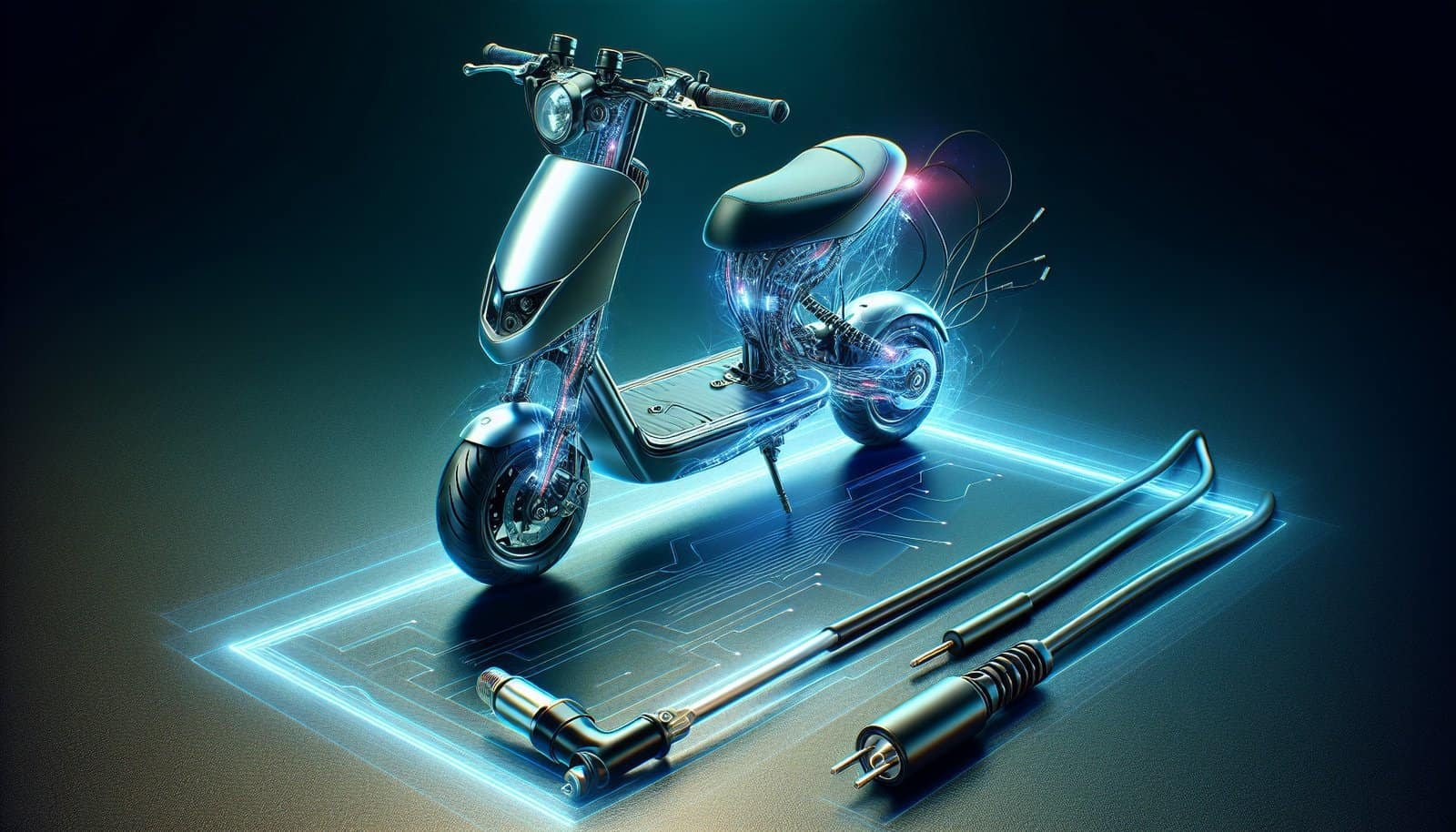So you’ve got yourself an electric scooter and it’s been zipping you around town, but now you’re noticing a decline in performance or a change in how the throttle and brake feel. Don’t worry, we’ve got you covered! In this article, we’ll guide you through the simple yet essential process of checking and replacing the throttle and brake cables on your electric scooter. By the end, you’ll be back on the road, enjoying smooth rides and confident stops in no time. Let’s get started!

Throttle Cable Inspection
When it comes to maintaining your electric scooter, one crucial aspect is the inspection of the throttle cable. The throttle cable is responsible for controlling the speed and acceleration of your scooter, so it’s important to ensure that it is in good condition. There are two main aspects to consider during the inspection: visual inspection and functional inspection.
Visual Inspection
To begin the visual inspection, start by visually examining the entire length of the throttle cable. Look for any signs of fraying or damage, such as cuts, tears, or exposed wires. These are red flags that indicate the cable needs to be replaced. Additionally, check the cable housing for any cracks or damage that may compromise its integrity. Any issues found during the visual inspection should be addressed promptly to ensure optimal performance and safety.
Functional Inspection
The functional inspection of the throttle cable focuses on its operation and response. Start by firmly gripping the throttle and slowly twisting it. Observe how smoothly the throttle moves and make sure there is no sticking or resistance. A smooth and fluid throttle operation is essential for a seamless riding experience. Additionally, pay attention to the throttle’s return. After releasing the throttle, it should spring back to its original position promptly and without delay. If you notice any irregularities during the functional inspection, it may indicate a problem with the throttle cable that requires replacement.
Throttle Cable Replacement
If your throttle cable fails the inspection or you suspect that it is causing issues with your scooter’s performance, it may be time to replace it. Follow these steps to safely and effectively replace the throttle cable.
Gathering Tools and Parts
Before starting the replacement process, gather all the necessary tools and parts. Here’s what you’ll need:
- Allen wrench
- Screwdriver
- Adjustable wrench
- Pliers
- Replacement throttle cable
- Grease or lubricant
- Clean cloth
Make sure you have everything ready before proceeding with the replacement.
Disconnecting the Old Throttle Cable
To disconnect the old throttle cable, locate its connection point on the scooter’s handlebars. Depending on your scooter model, this may involve removing a cover or panel. Once you have access, loosen the fasteners securing the cable and carefully detach it from the throttle assembly. Take note of how the old cable is routed and connected for reference when installing the new cable.
Installing the New Throttle Cable
Now it’s time to install the new throttle cable. Begin by applying a small amount of grease or lubricant to the cable, ensuring smooth movement. Route the new cable along the same path as the old one, making sure it is properly aligned. Reattach the cable to the throttle assembly, securing it tightly with the fasteners. Double-check all connections and ensure the cable is free from any obstructions before continuing.
Brake Cable Inspection
Just as important as the throttle cable is the brake cable. Regular inspection of your electric scooter’s brake cable is essential for maintaining optimal braking performance and rider safety. Similar to the throttle cable inspection, the brake cable inspection should include both a visual and functional assessment.
Visual Inspection
Begin the visual inspection by carefully examining the entire length of the brake cable. Look for any signs of fraying, kinks, or damage. Pay close attention to the brake cable housing as well, checking for any cracks or dents that could compromise its functionality. If any issues are detected during the visual inspection, it is recommended to have the cable replaced to ensure reliable and safe braking.
Functional Inspection
To perform the functional inspection of the brake cable, engage the brake lever and observe the brake pads or disc. Ensure that there is an adequate amount of brake pad material or that the disc is in good condition. Test the brake lever’s response and make sure there is no excessive play or resistance. Proper brake cable function is crucial for efficient braking, so any anomalies should be addressed promptly.
Brake Cable Replacement
If the brake cable is found to be faulty or damaged during the inspection, it’s important to replace it to maintain optimal braking performance. Follow these steps to correctly replace the brake cable.
Gathering Tools and Parts
Before beginning the replacement process, gather the required tools and parts. Here’s what you’ll need:
- Allen wrench
- Screwdriver
- Adjustable wrench
- Pliers
- Replacement brake cable
- Grease or lubricant
- Clean cloth
Having these tools and parts at hand will make the replacement process smoother.
Disconnecting the Old Brake Cable
To disconnect the old brake cable, locate its connection points on the scooter. This may involve removing covers or panels to gain access. Once you have access, loosen the fasteners securing the cable and carefully detach it from the brake handle and caliper assembly. Take note of the cable routing and connections to ensure proper installation of the new brake cable.
Installing the New Brake Cable
Start by applying a small amount of grease or lubricant to the new brake cable for smooth operation. Route the new cable along the same path as the old one, making sure it aligns correctly. Attach the new cable to the brake handle and caliper assembly, securing it tightly with the fasteners. Confirm that all connections are secure and free from obstructions before continuing.

Tools and Materials Needed
To successfully carry out the inspections and replacements of the throttle and brake cables, make sure you have the following tools and materials on hand:
- Allen wrench: for loosening and tightening various fasteners.
- Screwdriver: for removing and installing screws.
- Adjustable wrench: for handling different sizes of nuts and bolts.
- Pliers: for gripping and manipulating small parts.
- Replacement throttle cable: in case a replacement is necessary.
- Replacement brake cable: for replacing a faulty or damaged brake cable.
- Grease or lubricant: for smooth operation of the cables.
- Clean cloth: for wiping down any dirt or debris.
- Safety goggles: to protect your eyes from any potential hazards.
- Work gloves: to provide hand protection during the maintenance tasks.
Having these tools and materials readily available will ensure a smooth and efficient process.
Preparation
Before proceeding with the inspections and replacements, a few steps of preparation are necessary to ensure a safe and optimal working environment.
Choose a Well-Lit and Flat Work Area
Find a well-lit area with enough space to comfortably work on your electric scooter. Ensure that the space is flat and free from any potential hazards that could pose a risk during the maintenance process.
Put on Safety Goggles and Work Gloves
To protect your eyes from any debris or particles and to provide hand protection during the maintenance tasks, put on a pair of safety goggles and work gloves before starting any work on your electric scooter.
With these preparations in place, you are ready to begin inspecting and replacing the throttle and brake cables of your electric scooter.

Throttle Cable Inspection: Visual Inspection
The visual inspection of the throttle cable is crucial for identifying any visible signs of damage or wear. Follow these steps to perform a thorough visual inspection.
Check for Cable Fraying or Damage
Inspect the entire length of the throttle cable, paying close attention to any signs of fraying, cuts, tears, or exposed wires. These are indications that the cable has reached the end of its lifespan and should be replaced.
Inspect the Cable Housing
Examine the cable housing for any cracks or damage. Cracked or compromised housing can lead to cable failure and should be replaced promptly to ensure safe and reliable operation.
Evaluate the Cable Connections
Ensure that all cable connections are securely fastened and free from any debris or obstructions. Loose or improperly connected cables can affect the throttle’s performance and reliability. Double-check all connections and make any necessary adjustments or repairs.
Throttle Cable Inspection: Functional Inspection
The functional inspection of the throttle cable focuses on its operation and responsiveness. Follow these steps to perform a functional inspection.
Check for Smooth Throttle Operation
Grip the throttle firmly and twist it slowly, observing how smoothly it moves. The throttle should move without any sticking or resistance, providing a seamless and responsive control over the scooter’s speed. If you notice any irregularities such as stiffness or rough movements, it may indicate a problem with the throttle cable that requires replacement.
Ensure Proper Return of the Throttle
After releasing the throttle, it should return to its original position promptly and smoothly. A delay or sluggish return can interfere with the scooter’s operation and compromise its safety. If the throttle fails to return properly, investigate further and address the issue promptly.

Brake Cable Replacement: Installing the New Brake Cable
If the brake cable fails the inspection or is damaged, it’s necessary to replace it to ensure optimal braking performance. Follow these steps to install the new brake cable.
Attach the New Cable to the Brake Lever Assembly
Begin by attaching the new brake cable to the brake lever assembly. Ensure that the connection is secure and free from any looseness or play.
Secure the Cable to its Mounting Points
Route the new brake cable along the same path as the old one, aligning it correctly. Securely fasten the cable to its designated mounting points, ensuring a tight and secure fit. Double-check all connections and make adjustments as needed.
Test the Brake Operation
After installing the new brake cable, thoroughly test the brake operation to ensure that it functions properly. Engage the brake lever and confirm that the brake pads or disc engage promptly and with sufficient force. Pay close attention to any abnormal noises or sensations and address them immediately if present.
By following these step-by-step instructions, you can confidently perform inspections and replacements of the throttle and brake cables on your electric scooter. Regular maintenance and timely replacements will optimize your scooter’s performance and ensure your safety while riding.

